Every March sees the Fred Hall Show in Long Beach, a huge event filled with a plethora of booths and vendors offering merchandise and dreams that should be able to fill the cravings of every visiting angler. The sheer size of the show can be somewhat overwhelming and by the time a person leaves they’re probably more than a little tired. Few have the time or interest to wonder about the history of the area itself—as I do.
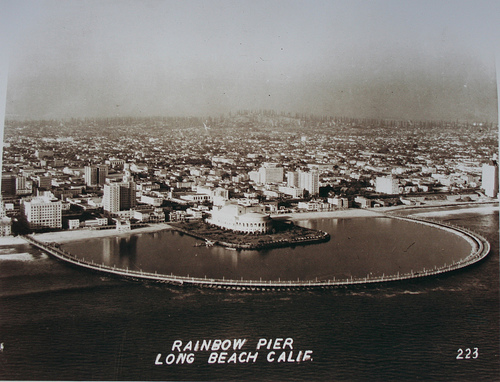
The setting, for me, is especially interesting given the contrast today with what was seen a hundred years ago. Today, if you stand at the corner of Pine Avenue and Ocean Avenue and look seaward, you will see the side of the large Long Beach Convention and Entertainment Center (where the show is held), a pavilion-like steeple at the Shoreline Village, and weird robot-like gantry cranes (which look like something out of the Star Wars movie) off in the distance where the container ships load and unload.
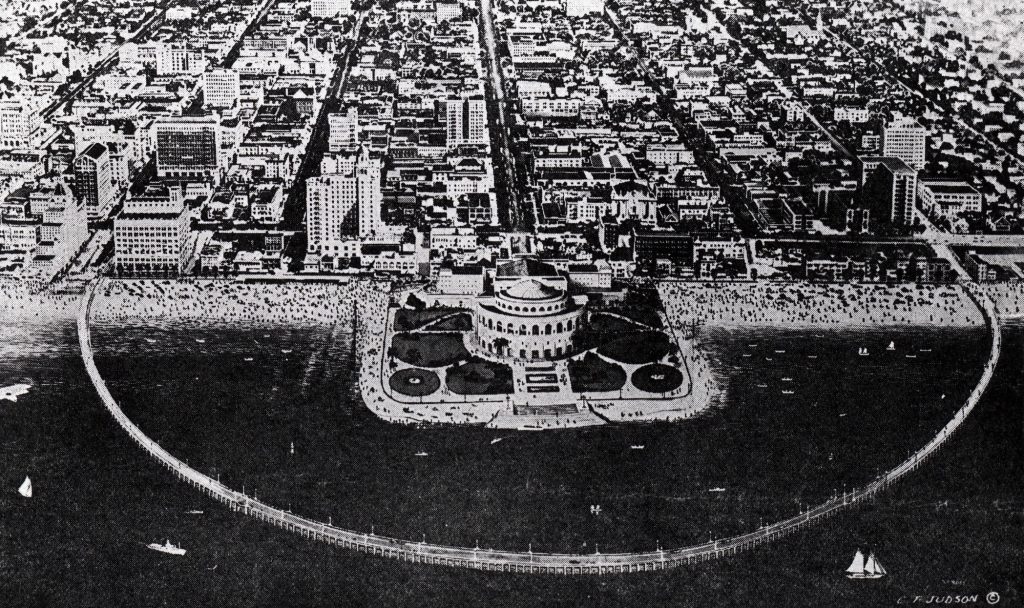
The wide beachfront area that once characterized Long Beach has been replaced by landfill, while roads lead westward to the Shoreline Aquatic Park and Village, and to the restaurant and shopping area adjacent to the Aquarium dubbed the “Pike” area (complete with lights that simulate a roller coaster). A small freshwater lagoon, adjacent to the convention center is dubbed the Rainbow Lagoon Park.
The names Pike and Rainbow give nod to the time a century ago when the “Pike” at Long Beach was one of the largest amusement areas on the West Coast and the “Rainbow Pier” was one of the largest piers.
From its inception Long Beach had felt piers were a necessity both to attract visitors and new residents. The Magnolia Avenue Pier was built in 1885 but unfortunately was short lived, lasting only until 1892.
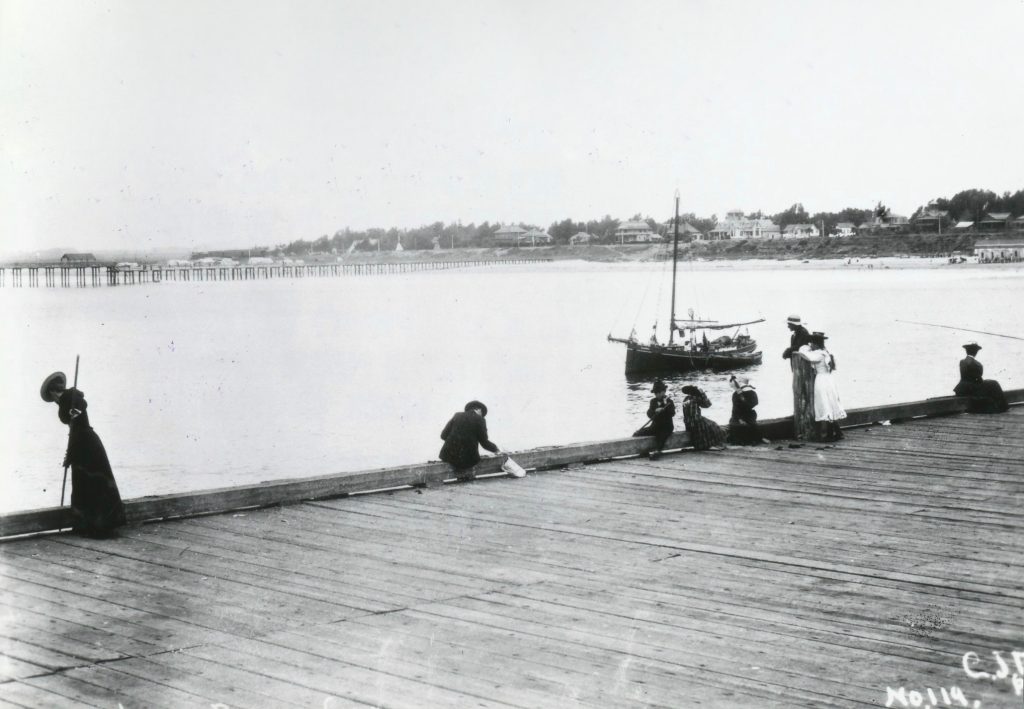
It was followed by the first Pine Avenue Pier, which was also short lived, surviving a single decade, 1893 to 1903.
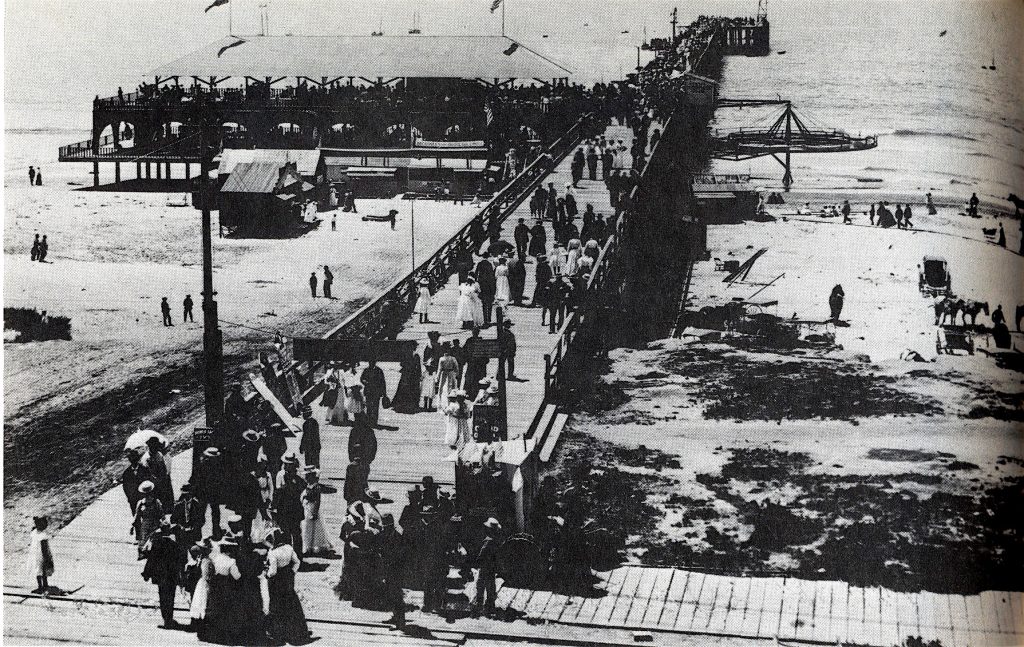
A new pier would be needed following storm damage and soon after, in 1904, a new, magnificent, double-decked Pine Ave Pier (the Municipal Pier) would be created and it would hang on, just barely, until 1934 when it was finally demolished.
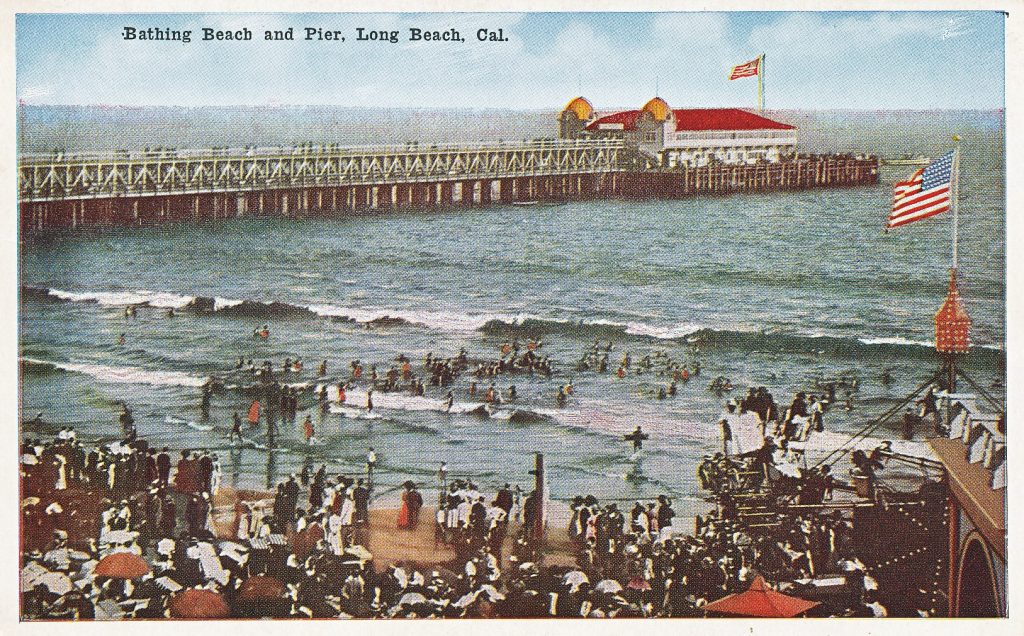
Another pier, down shore from the main pier, would open on Christmas Day 1915. It was dubbed the Grand Avenue or Belmont Heights Pier (although called the Devil’s Gate Pier by most of the locals).
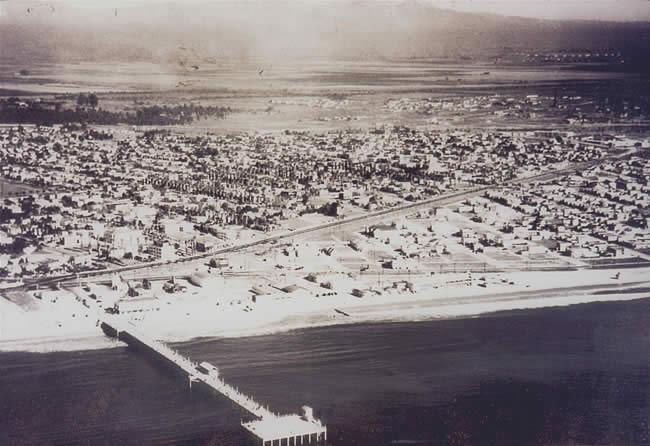
By the 1960s it needed replacement and in 1967 a new Belmont Pier, today called the Belmont Veterans Memorial Pier was opened. That’s another story.
Perhaps the most interesting pier was the Rainbow Pier. By the 1930s and the advent of the Great Depression, the Pike amusement area was starting to see decline while the Pine Avenue Pier, a pier that had seen repeated damage, was in need of repair. However, a new chapter in the story of the downtown shoreline area took place.
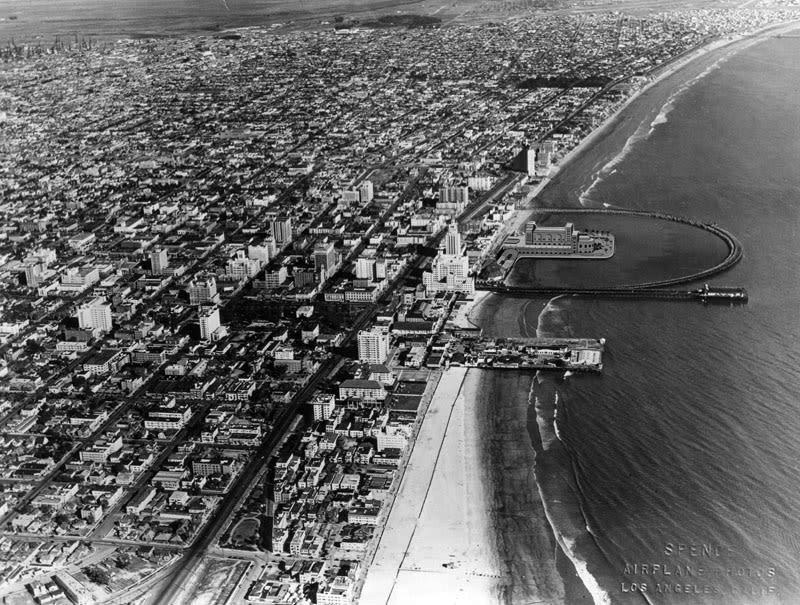
On July 25, 1931 the Rainbow Pier was officially opened just to the south of the Pine Avenue Pier. The 3,800-foot, horseshoe-shaped pier, curved offshore from Linden Avenue to Pine Avenue, or a distance of 1,350 feet over the Pacific. It was one of the most impressive piers ever built along the coast (even if angling was only a small part of the pier’s life) and became a “must see” attraction for visitors to Long Beach.
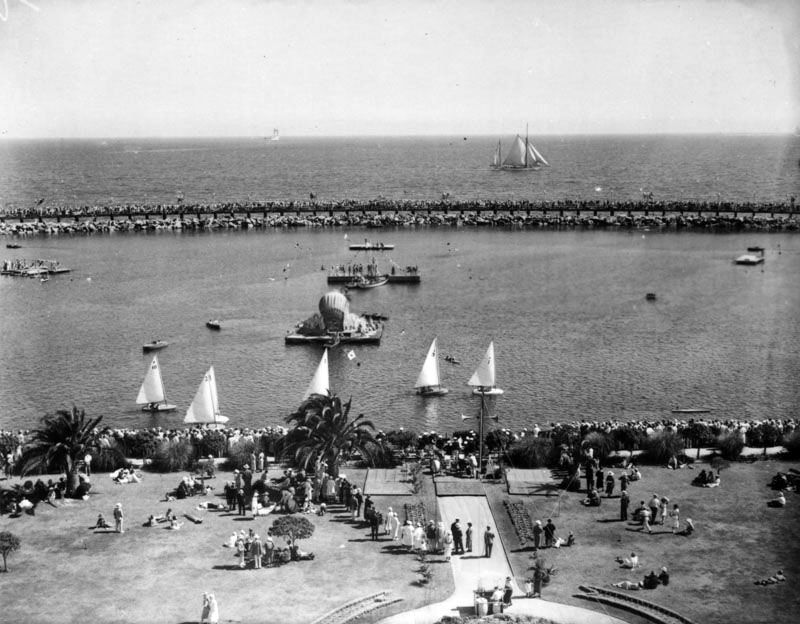
The “Pier Without Peer” had a 36-foot-wide roadway built on top of 330,000 tons of rock and supposedly 75,000 people could stand on the pier at one time. Inside the horseshoe was located the Rainbow Lagoon which quickly became one of the best places to swim in the southland, and onshore was built a Municipal Auditorium.
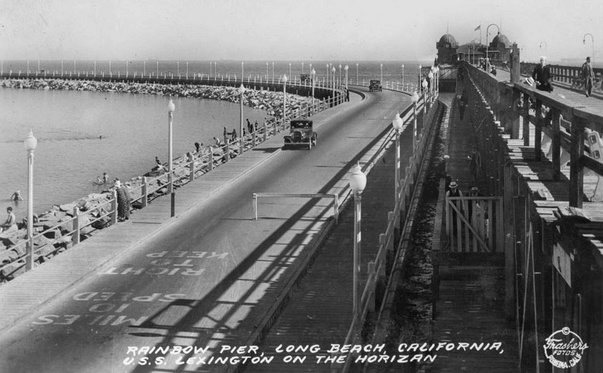
At night, multicolored lights reflecting on the lagoon created a rainbow effect. (During WWII the lights were first blacked out on the ocean side of the pier. Soon after, all of the lights were turned off and cars were stopped from going onto the pier. Apparently after the war ended white lights were installed but eventually colored lights replaced them once again.)
The Rainbow Pier had first been proposed back in 1910 by businessman S.J. Abrams as a grandiose double-decked Horseshoe Pier. It was to include a “capacious” sun parlor at the outermost point, a public bathing place, a wide space for automobiles, nine landing piers for boats, space on the lower deck for pedestrians and fishermen, and a separate concrete fishing pier extending from the southwest corner. Many of his ideas were later adopted by the city, but it took nearly twenty years and a $2.8 million bond issue in 1928 (for the pier and auditorium) before the pier was built.
1933 a part of the Pine Avenue Pier was resurfaced, new pilings were installed, and it became a spur which connected out from the seaward end of the Rainbow Pier. But the final day for the Pine Avenue Pier was close at hand. A storm in September of 1934 finally destroyed the pier.
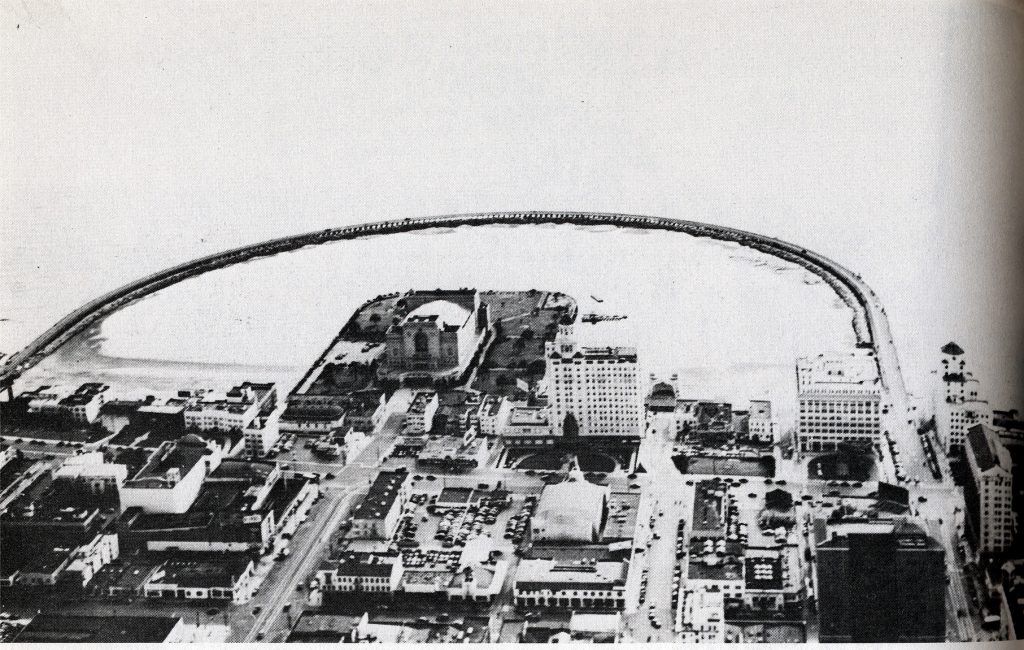
As for the fishing from the Rainbow Pier, it was fairly undistinguished. It was noted for many large bat rays and a variety of sharks, including angel sharks, but the catch for most sport fish was similar to other area piers with one exception. Due undoubtedly to the rocks under the pier, it offered up better than average fishing for some rocky habitat species such as perch.
One unusual catch, supposedly a record at the time, was a 7-pound, 3-ounce spotfin croaker taken in 1961 by C. J. Yochelson. It was believed to be a world record for two-pound test line.
For a period of time, fishing barges did offer fishing not too far offshore from the Rainbow Pier. In the ‘40s one could fish from the schooner “Bounty.” The ‘50s would see a different barge, the “Rainbow Barge.”
Damage did occasionally occur to the pier (although it showed little damage from many storms that damaged other piers). Most of the pier’s damage was not from storms but from aging pilings. As example, for most of its life cars had been permitted to drive on the Rainbow Pier but in 1946 the pier was closed to traffic due to piling damage. (At the same time some proposed filling in the Rainbow Lagoon and turning it into a parking lot.) By August of that year four (expensive) proposals had been made for rehabilitating the pier. In time, traffic would be allowed back onto the pier.
In August 1948 work began on fixing the pier, work that included replacing many pilings. Shortly thereafter new plans were announced for turning the lagoon into a seaside park with bathing areas, a band shell, a grandstand for aquatic events and other features.
Unfortunately what man can create, man and Mother Nature can also destroy. The area began to sink, apparently as a result of local oil wells, and tidal action deposited sand inside the lagoon. As a result of these two changes, the lagoon area was filled with dirt in 1955.
In addition, thousands of dollars were required annually for the upkeep of the pier pilings. By the mid ‘60s, it was apparent that a major rebuild would be necessary, an expense the city was not willing to pay. Instead, a decision was made to demolish the pier. March 20, 1966, was the last day of the Rainbow Pier and in its place came a 113-acre landfill that reached, at some points, a quarter-mile seaward.
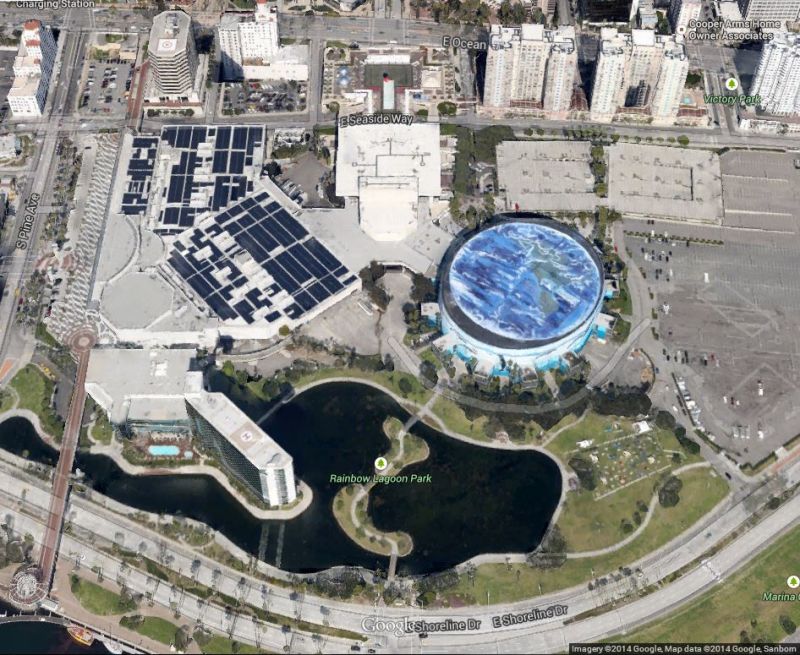
Today one sees a marina, shopping area, and (if one circles the outside road) several small finger piers that still allow one to fish
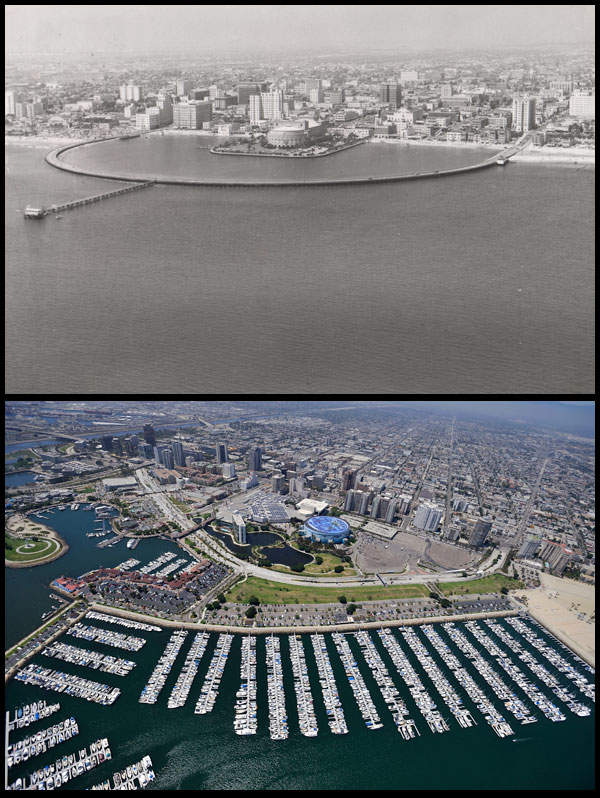
What had been dubbed “The Peerless Pier” would now be only history — gone but not forgotten.
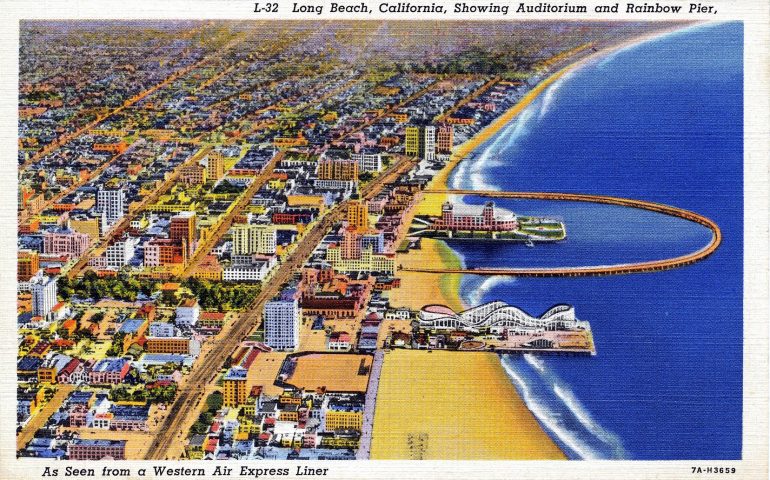
I lived in Torey Pines Apartment 3rd floor 1931-the earthquake ’33. We looked out over the pier and its long curve and the Pacific Fleet ( USS Lexington, USS Saratoga) and spent many Sundays visiting the Naval ships. Thank you for the news of the Rain Bow and stirring up many happy memories.
My sister and I have many happy memories of Rainbow Pier when we were kids. Mom and Dad drove us around the pier in the early evening when the multi-colored street lights on both sides of the pier came on, making us girls ooh and aah at all the colors! For us, this was a very special ride and would beg daddy to go around again. So sorry the pier was torn down, but I guess it was prime real estate and wasn’t a money maker.
I wish I had seen it before they demolished it. Ken
My father was a man who loved “the bay”, that’s what he called the
lagoon within rainbow Pier.
He would swim in the bay everyday possible at the end of his shift at one in the afternoon. Nearly every Sunday in the summer
he would pack in the car and head to Long Beach and the bay and we all enjoyed a day at the beach. The Long Beach bay and
Pike were a large part of our lives. After my brother and I were married and moved out of L. A. My father would load up the car with all the
neighbor hood kids and head for the bay to spend the day swimming.
I fished on Rainbow Pier in summers from 1949 to 1951, with up to ten hours
fishing dawn to dusk. My dad ran a bindery, I liked to fish and documented all
my catch with data.
I would love to know about your experiences those years and what you caught. My email is kenjones@pierfishing.com
Best wishes.
I loved that pier, born in Long Beach so as kids we spent a lot of time there. The whole atmosphere was magical and we had so much fun. I was really sad to see it all go to see that
TY for this insightful article. I often walk the ‘finger pier’ (new vocabulary for me) on the west end of Shoreline Marina. I grew up in San Pedro and observed some of the changes mentioned but it’s great to get the facts presented so clearly!
BOB GORBOULD I LIVED IN THE KEYSTONE APARTMENTS LOOKING OUT OVER THE LAGOON WHICH WAS ON THE INSIDE OF RAINBOW PIER. LIVED THERE FROM1943 UNTIL I WAS 11YEARS OLD. THE MEMORIES I HAVE OF GROWING UP THERE ARE THE BEST OF MY LIFE.
I feel that when Long Beach destroyed Rainbow Pier, Silver Spray Pier, the Cyclone Racer the Pike and the beach they killed the goose that laid the golden egg. Having written that, does anyone recall when the plane crashed in Rainbow Lagoon? Like so many others, as a teen ager I hung around the lifeguard tower. One day Harold King, the lifeguard sent me out with the dory to patrol the rocks around the pier. At about the halfway mark a plane was flying around then came straight down about 100 feet from where I was. Not knowing what to do I think I might have broken some sort of record rowing back to the beach where Harold told me to get up in the tower and watch the beach. DID I FEEL IMPORTANT? You better believe it. It was a tragedy but I’ll always remember it.
When I was a teenager 14 16 my favorit place was the Long Beach Pike We would ride
the roller coaster 3 or 4 times for 25 cents a ride. It was a blast!
One night, we were driving around Rainbow pier and the waves were coming up over onto the pier
coming up over the pier We were thrilled We even got wet! Fantastic memories Today I drove from Arcadia in search of the location of the iconic Rainbow pier
Thinking back I have another comment about Rainbow Lagoon. At about twelve years I started
going to the beach and felt Rainbow Lagoon was a good place to learn. Eventually, I got good.
Since the lifeguard, Harold King who we in the “gang” all liked and respected went to the Fire
Department I decided to go try my hand at body surfing. My days at the lagoon will always
bring back a lot of very pleasant memories. I’m now 97 and live in another state but the
memories are still there. I now realize the lagoon might not have been the best place to swim
but it was a good place to learn before it was destroyed by a bunch of greedy city politicians
In fact the area could have been cleaned up and made more presentable. I believe in progress
but what has been done to LONG BEACH a city named for the beach that no longer exists
went absolutely overboard. I could go on and on about what’s been done to a city that once
had beautiful beaches that no longer exist and a skyline I’ve seen from the sea that was
absolutely fantastic. The place where I grew up has gone absolutely too far.
Around 1953-54, as a 9yr old boy, I walked from home near PCH to Rainbow Pier on summer days (saving the two five-cent bus moneys for
candy), and swam in the beach at Rainbow Pier. Some boy had a raft and invited other boys like me to row it with him inside the pier. It was cool,
rowing to mid-pier and climbing the support rocks; but Toby the lifeguard soon told us to remove the raft, it wasn’t allowed for safety reasons.
Trip Kraus, I share your feelings. At the time I had no idea what the lagoon might mean to me later in life. In later years , I’m now in my late 90s I realize my time spent there really meant a lot. There was a lot there that we no longer experience and enjoy.
Best years of my life was the 60s in Long Beach on the Beach. Loved Seafare trampoline. It sadden me when the pier was taken away and filled in. Always enjoyed walking around it. The beach off of Linden was my place to enjoy the sun. Yes, lots of great memories.
Such a nostalgic trip down memory lane! Rainbow Pier holds so many special memories for Long Beach—truly gone but never forgotten.
Khi nhắc đến cá cược trực tuyến tại châu Á, W88 không còn là cái tên xa lạ. Đây không chỉ là một nhà cái thông thường mà còn là một biểu tượng cho sự đẳng cấp, uy tín và chuyên nghiệp.
Thank you for this informative post. High-quality content like this consistently engages readers.
Great post. couldn’t believe it is no longer exists.
The Rainbow Pier was a remarkable part of Long Beach’s history. Opened in 1931, this 3,800-foot horseshoe-shaped structure was among the first piers designed for automobiles, allowing cars to drive its graceful arc from Linden Avenue to Pine Avenue . Enclosing the 40-acre Rainbow Lagoon, it provided a serene spot for swimming and boating, while its multicolored lights at night created a stunning rainbow reflection on the water .
Reddit+7Pier Fishing in California+7Long Beach Post+7
PBS SoCal+2Long Beach Post+2Pier Fishing in California+2
Atomic Redhead+3(no title)+3PBS SoCal+3
Although the pier was demolished in 1966 to make way for developments like the Long Beach Convention Center, its legacy endures in the city’s cultural memory .
PBS SoCal
If you ever find yourself fishing in Long Beach and your car decides to take a break, don’t hesitate to contact Saar Shani Towing. They’re reliable and ready to assist when you need them most.
Vsport là nhà cái uy tín chuyên về cá cược thể thao với nhiều bộ môn hấp dẫn, tỷ lệ trả thưởng cao. Bài viết sau sẽ cung cấp đầy đủ thông tin giúp bạn hiểu rõ hơn về sân chơi này.